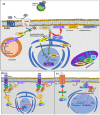Targeting Sphingosine-1-Phosphate Signaling in Immune-Mediated Diseases: Beyond Multiple Sclerosis
- PMID: 33983615
- PMCID: PMC8116828
- DOI: 10.1007/s40265-021-01528-8
Targeting Sphingosine-1-Phosphate Signaling in Immune-Mediated Diseases: Beyond Multiple Sclerosis
Erratum in
-
Correction to: Targeting Sphingosine-1-Phosphate Signaling in Immune-Mediated Diseases: Beyond Multiple Sclerosis.Drugs. 2021 Aug;81(12):1451. doi: 10.1007/s40265-021-01577-z. Drugs. 2021. PMID: 34328627 Free PMC article. No abstract available.
Abstract
Sphingosine-1-phosphate (S1P) is a bioactive lipid metabolite that exerts its actions by engaging 5 G-protein-coupled receptors (S1PR1-S1PR5). S1P receptors are involved in several cellular and physiological events, including lymphocyte/hematopoietic cell trafficking. An S1P gradient (low in tissues, high in blood), maintained by synthetic and degradative enzymes, regulates lymphocyte trafficking. Because lymphocytes live long (which is critical for adaptive immunity) and recirculate thousands of times, the S1P-S1PR pathway is involved in the pathogenesis of immune-mediated diseases. The S1PR1 modulators lead to receptor internalization, subsequent ubiquitination, and proteasome degradation, which renders lymphocytes incapable of following the S1P gradient and prevents their access to inflammation sites. These drugs might also block lymphocyte egress from lymph nodes by inhibiting transendothelial migration. Targeting S1PRs as a therapeutic strategy was first employed for multiple sclerosis (MS), and four S1P modulators (fingolimod, siponimod, ozanimod, and ponesimod) are currently approved for its treatment. New S1PR modulators are under clinical development for MS, and their uses are being evaluated to treat other immune-mediated diseases, including inflammatory bowel disease (IBD), rheumatoid arthritis (RA), systemic lupus erythematosus (SLE), and psoriasis. A clinical trial in patients with COVID-19 treated with ozanimod is ongoing. Ozanimod and etrasimod have shown promising results in IBD; while in phase 2 clinical trials, ponesimod has shown improvement in 77% of the patients with psoriasis. Cenerimod and amiselimod have been tested in SLE patients. Fingolimod, etrasimod, and IMMH001 have shown efficacy in RA preclinical studies. Concerns relating to S1PR modulators are leukopenia, anemia, transaminase elevation, macular edema, teratogenicity, pulmonary disorders, infections, and cardiovascular events. Furthermore, S1PR modulators exhibit different pharmacokinetics; a well-established first-dose event associated with S1PR modulators can be mitigated by gradual up-titration. In conclusion, S1P modulators represent a novel and promising therapeutic strategy for immune-mediated diseases.
Conflict of interest statement
The authors have no relevant conflicts of interest.
Figures

References
-
- Peyrin-Biroulet L, Christopher R, Behan D, Lassen C. Modulation of sphingosine-1-phosphate in inflammatory bowel disease. Autoimmun Rev. 2017;16(5):495–503. - PubMed
-
- Tsai HC, Han MH. Sphingosine-1-phosphate (S1P) and S1P signaling pathway: therapeutic targets in autoimmunity and inflammation. Drugs. 2016;76(11):1067–1079. - PubMed
Publication types
MeSH terms
Substances
Grants and funding
LinkOut - more resources
Full Text Sources
Other Literature Sources
Medical

